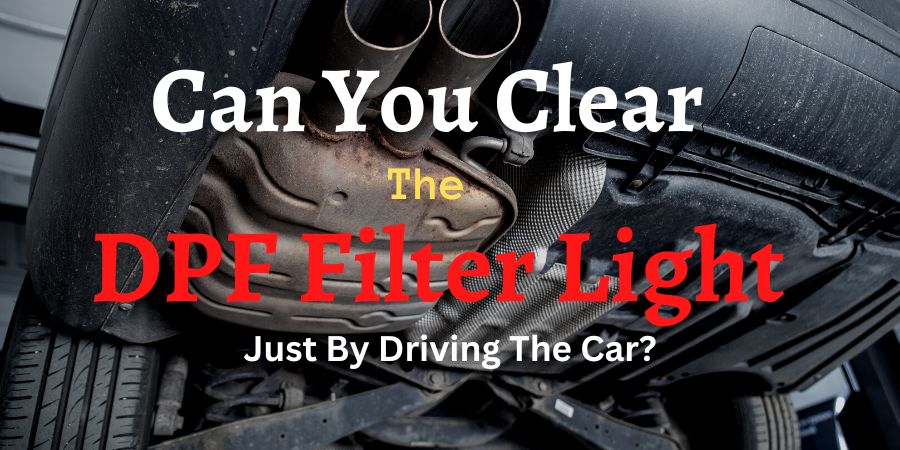
Can You Clear The Dpf Light By Driving The Car
You can often clear the Diesel Particulate Filter (DPF) warning light on your dashboard by driving your car under certain conditions. The DPF is a component of the exhaust system designed to capture and store soot particles from diesel engines, helping to reduce emissions.
Over time, the filter becomes clogged with these particles, and it needs to undergo a ” regeneration ” process to burn them off.
To clear the DPF light and initiate a regeneration cycle, you can follow these general guidelines:
- Drive at a constant speed: Maintain a steady speed of around 40-50 mph (60-80 km/h) for at least 20-30 minutes. This will allow the engine to reach its optimal operating temperature and help regeneration.
- Choose the appropriate gear: Use a higher gear (e.g., 4th or 5th) to ensure the engine RPM is around 2000-2500. This will help create enough exhaust gas temperature to burn off the soot in the DPF.
- Avoid short journeys: Frequent short trips can prevent the engine from reaching the temperatures needed for regeneration. Plan longer trips whenever possible to help maintain your DPF.
Remember that these are general guidelines, and it’s essential to consult your vehicle’s owner’s manual for specific information about your car’s DPF system and the recommended procedure to initiate regeneration.
If the DPF light does not go off after following these steps or comes back on soon after, you may need to consult a professional mechanic, as there could be an underlying issue with the DPF system.
What Is The Dpf Light?
The DPF light on the dashboard is a warning light that typically appears in diesel-powered vehicles, indicating that the diesel particulate filter is experiencing issues or requires maintenance.
The diesel particulate filter is an essential component of the exhaust system, designed to capture and store soot particles produced during combustion in diesel engines. This helps reduce harmful emissions and improve air quality. Over time, the filter becomes saturated with particles and needs to be cleaned or “regenerated” by burning off the accumulated soot.
If the DPF light comes on, it may indicate one of the following:
- The filter is full, and a regeneration process is required.
- The filter has a problem, such as a blockage or damage.
- There is a malfunction in the system that manages the regeneration process, such as a sensor or software issue.
If the DPF light comes on, it is important to address it immediately. Neglecting it could lead to reduced engine performance, increased fuel consumption, or even damage to the filter or engine.
It is recommended to consult your vehicle’s owner’s manual or consult a qualified mechanic for further guidance.
When Is It Not Recommended To Drive A Car To Clear The Dpf Light?
It is not recommended to drive a car to clear the Diesel Particulate Filter (DPF) light in the following situations:
- Poor vehicle condition: If your vehicle is in poor condition, has engine issues, or has warning lights other than the DPF light illuminated, driving to clear the DPF light may exacerbate the problem or lead to further damage.
- DPF severely blocked or damaged: If the DPF is severely blocked or damaged, attempting to clear it by driving may be ineffective and can cause more harm to the engine or the exhaust system. In this case, consulting a professional mechanic or taking the car to a service center is better.
- Exceeding the allowed regeneration cycles: Each DPF has a limited number of regeneration cycles it can undergo. If your vehicle’s DPF has already undergone numerous regenerations, it may be time to replace it instead of trying to clear the light by driving.
- Insufficient time or space for a proper regeneration drive: To clear the DPF light, you typically need to drive at a consistent speed (usually above 40 mph or 60 km/h) for 20-30 minutes. If you cannot maintain this speed or do not have enough time to complete the drive, it is not recommended to attempt clearing the DPF light.
In any of these situations, it is best to consult a professional mechanic or take your car to a service center to address the issue.
Correct Use Of Engine Oil
Diesel Particulate Filters (DPF) are designed to reduce the amount of particulate matter (soot) in diesel engine exhaust. To help keep the DPF clean and functioning properly, it’s essential to use the correct engine oil.
Here are a few tips on choosing the right engine oil for your diesel engine:
- Low SAPS oil: Select a low Sulfated Ash, Phosphorus, and Sulfur (SAPS) engine oil. These oils contain fewer metal additives that can block the DPF and lead to increased soot accumulation.
- ACEA specification: Check your vehicle’s owner manual for the appropriate ACEA (Association des Constructeurs Européens d’Automobiles) specification. Generally, diesel engines with DPF should use engine oils that meet the ACEA C-class specifications, such as ACEA C1, ACEA C2, ACEA C3, ACEA C4, or ACEA C5. These oils are specifically designed for compatibility with DPF systems.
- OEM recommendations: Always follow the vehicle manufacturer’s oil viscosity and performance level recommendations. This information can typically be found in the owner’s manual or on a sticker under the hood or engine.
- Regular oil changes: Stick to your vehicle’s recommended oil change intervals, as specified in the owner’s manual. Regular oil changes will help keep the DPF clean and maintain optimal engine performance.
Each vehicle’s requirements can vary, so always refer to your owner’s manual or consult a professional mechanic to determine the best engine oil for your specific diesel engine with a DPF.
Conclusion
The DPF dashboard light is an important indicator of your car’s overall health, and it is essential to take the necessary steps to reset it.
If the light is illuminated, the best action is to take the car to a certified mechanic who can diagnose the issue and provide you with the best repair plan.
You can do what most people do first and try the long run down the motorway at a good speed of around 60 mph to see if that will burn off some of the excess carbon inside your filter. Should this fail you will most definitely need to go to a garage to get it sorted and cleaned.
